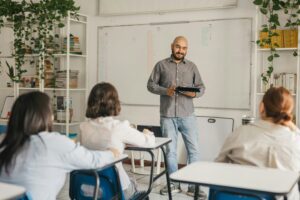Learning Divides: Cutting-Edge Strategies for Today’s Educators


Educational disparities pose significant challenges in classrooms worldwide, making it imperative for today’s educators to employ cutting-edge strategies to bridge these divides. This article explores a range of innovative teaching methods tailored to meet diverse student needs, enhance engagement, and promote equitable learning outcomes.
Personalized Learning: Tailoring Education to the Student
Recognizing that students learn at different paces and in varied ways, personalized learning adapts to individual learning styles and speeds, offering each student a customized educational experience.
Technology-Enhanced Adaptive Learning
Advanced technologies like AI-driven platforms analyze student data to customize learning materials and assessments, allowing teachers to address individual strengths and weaknesses effectively. These technologies also facilitate immediate feedback, helping students adjust their learning strategies in real time.
Implementing Differentiated Instruction
Differentiated instruction strategies involve modifying learning activities and assessments to accommodate diverse learning needs within the classroom. Teachers might offer varied reading materials, create multiple levels of homework assignments, or employ different teaching aids, such as videos, models, or interactive simulations, to cater to a wide range of learning preferences.
Collaborative Learning: Harnessing the Power of Peer Interaction
Collaborative learning strategies leverage the collective knowledge of the group to enhance individual and group comprehension, foster skill development, and reduce learning gaps.
Structured Group Work
Effective collaborative learning involves structured group tasks where students with varying abilities work together towards a common goal. Assigning specific roles within these groups can help ensure that all members contribute actively and benefit from their peers’ insights.
Peer-Assisted Learning Strategies
Peer-assisted learning not only supports students needing help but also reinforces the tutors’ understanding by teaching the content to their classmates. This reciprocal approach to education can dramatically improve comprehension and retention for both parties.
Culturally Responsive Teaching: Reflecting Student Diversity in Curriculum
Culturally responsive teaching increases engagement and achievement by reflecting the cultural backgrounds of students in the teaching materials and classroom activities.
Incorporating Multicultural Content
Teachers can include books, case studies, and examples from various cultures to make the curriculum more inclusive and relevant to students from diverse backgrounds. Celebrating different cultural traditions and histories in the classroom can help build a more supportive and inclusive learning environment.
Language Inclusion for English Language Learners
For English language learners, integrating bilingual resources and visual aids can help bridge communication gaps and foster a more inclusive classroom atmosphere. Offering additional language support through after-school programs or integrating language learning software can also be beneficial.
Strategic Use of Formative Assessments-Educators
Formative assessments are essential for identifying learning gaps and modifying instruction to meet student needs effectively.
Continuous Feedback
Regular use of short formative assessments provides essential feedback. To both students and teachers, highlighting areas that need attention and allowing for timely interventions.
Adaptive Testing
Utilizing adaptive testing methods can help personalize and adjust assessments. The difficulty is based on the student’s performance to measure each student’s knowledge and skills accurately.
Edutainment: Making Learning Engaging and Fun
Edutainment, or educational entertainment, transforms learning into an engaging, enjoyable activity, helping to motivate and retain student interest.
Gamification Techniques-Educators
Incorporating elements of gamification such as point systems, badges, and interactive challenges can make learning more exciting and engaging. Particularly for students who may struggle with traditional educational methods.
These strategies reflect a commitment to inclusive education and demonstrate how targeted interventions can effectively address learning gaps. By continually adapting these innovative teaching techniques, educators are enabling all students. To access and engage with the curriculum, fostering an educational environment where every student has the opportunity to excel.





